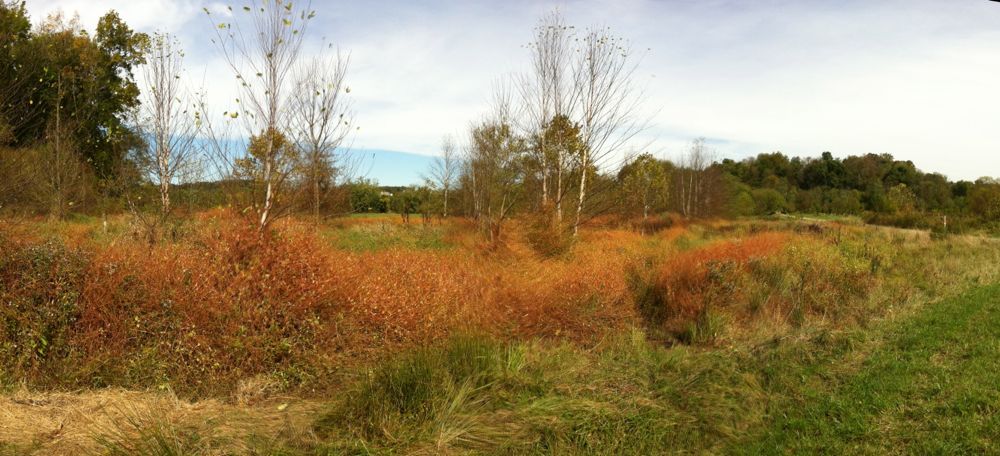The Stroud Preserve, 8 October 2013
/It has been quite a while since the last time I posted anything about birds at the Stroud Preserve. This is primarily due to the fact that I have not been birding there in quite a while. I spent much of the summer working on plants there. During much of the breeding season, my birding efforts were searching for birds that I thought might be here but couldn’t find, primarily woodland species like Hooded, Kentucky, Worm-eating and Prothonotary Warblers. I searched what I thought might be appropriate habitat listening and using playback to conclusively determine that they did not occur on the preserve. Looking for and not finding birds generally takes a lot of effort and produces a very boring species list.
The other complicating factor that has kept me away from the preserve since the first of August is that I secured a paying job after two years of unemployment. This was and especially difficult tasks because finding something in my career path (wildlife biology and ecology) is particularly difficult in Southeastern Pennsylvania. It is a position with a federal agency which has an intensive job training program in Maryland. So, I’ve been physically away from the area, which in turn, makes it hard to get out birding here. However, after seven weeks of steady work, I got furloughed. Such is life working in the public sector. It’s not the first time that I’ve had to deal with something like this and I’m sure it will not be the last.
The upside to being furloughed is that I got to go birding to day at the Stroud Preserve. I was hopeful that the storm front that passed through here yesterday would have brought waves of migrant birds to the east fork of the Brandywine Creek. And to this end, I was disappointed. The up side is that I did tally a new species for the preserve list! There were approximately 15 Dickcissels in the vegetation covering the old pond bed. These were the first Dickcissels that I have seen since returning to the east coast in August of 2011.
Other birds that were noteworthy were a pair of Kestrels and a single Merlin. The Kestrels were dive-bombing the Merlin. Once the Merlin was driven off, the Kestrels foraged along the fields on the north side of the preserve where the Bobolinks nest. There were also approximately 25 Snow Geese in two groups, in the first 15 followed by 10 more about 20 minutes later. They were both heading south-southwest.
What I didn’t see today were waves of migrant birds; only three warblers totaling 6 individuals. For the most part it was pretty quiet today. I did have stellar views of the Yellow-throated Vireo which is always nice. Since I have been away from the area for the last seven weeks I don’t really have a good grip on whether any of the birds that I saw today are early or late or otherwise.
Start time: 8:55
End time: 1:10
Temp: 54-63º
Wind: 5-7 from the north
Skies: Clear
Species Total: 46
- Black Vulture – 15
- Turkey Vulture – 25
- Snow Goose – 25
- Canada Goose – 10
- Mallard – 8
- Sharp-shinned Hawk – 1
- Cooper's Hawk – 3
- Red-tailed Hawk – 4
- American Kestrel – 2
- Merlin – 1
- Mourning Dove – 20
- Red-bellied Woodpecker – 4
- Downy Woodpecker – 4
- Northern Flicker – 2
- Pileated Woodpecker – 1, heard only
- Eastern Wood-Pewee – 2
- Yellow-throated Vireo – 1
- Blue Jay – 18
- American Crow – 30
- Fish Crow – 2
- Tree Swallow – 10
- Carolina Chickadee – 15
- Tufted Titmouse – 2
- White-breasted Nuthatch – 3
- Carolina Wren – 4
- House Wren – 2
- Ruby-crowned Kinglet – 2
- Eastern Bluebird – 8
- American Robin – 10
- Gray Catbird – 5
- Northern Mockingbird – 3
- European Starling – 5
- Cedar Waxwing – 55, in two flocks of approximately 25 and 30
- Yellow-rumped Warbler – 1
- Palm Warbler – 2
- Common Yellowthroat – 3
- Eastern Towhee – 10
- Song Sparrow – 20
- Lincoln's Sparrow – 5
- Swamp Sparrow – 15
- White-throated Sparrow – 10
- Northern Cardinal – 4
- Dickcissel – 15, New bird for the preserve! Approximate number as they were foraging in the vegetation of the old farm pond in a loose flock and were difficult to count. The most I observed at one time were 8.
- Red-winged Blackbird – 3
- House Finch – 15
- American Goldfinch – 25

